Welcome Message & Interactions
In both chatbot configurations Welcome Message and Interaction is where you define and manage how the chatbot communicates with users. It encompasses various elements designed to simulate a conversation, guide users through processes, or provide information.
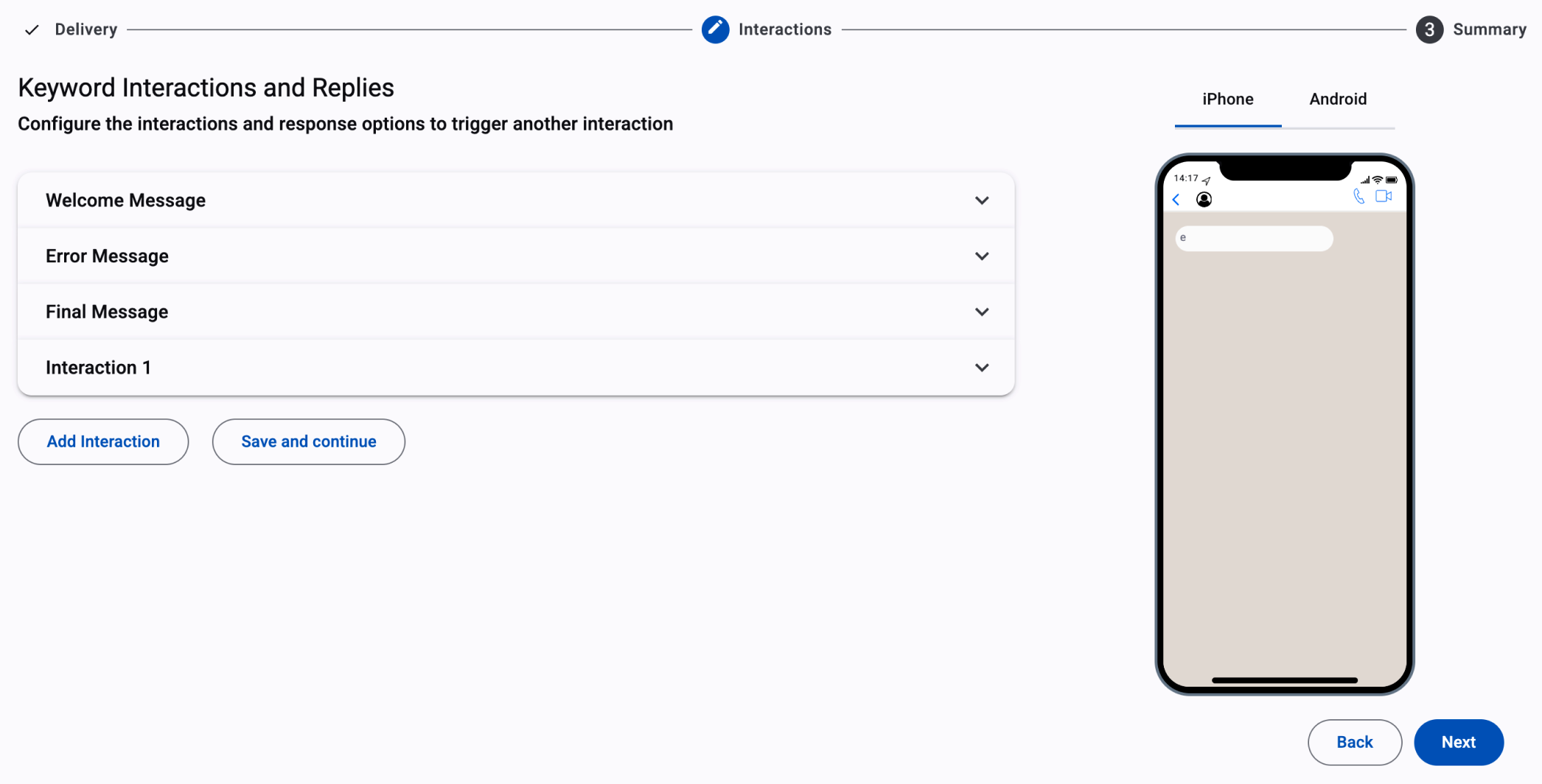
Key components often found in the Interactions section include:
User Prompts: Questions or statements that the chatbot presents to users, prompting them to provide information or make selections.
Bot Responses: The set of replies the chatbot can give in response to user inputs. These can range from predefined answers based on the user's previous inputs.**
Keywords: Specific words or phrases that, when typed by the user, trigger particular responses or actions from the chatbot.
Dialogue Flow: The logical structure that outlines how conversations progress based on different user responses or actions. This can include branching paths that lead to different outcomes depending on what the user says or selects.
Action Triggers: Configurations that specify actions the chatbot should take under certain conditions, like sending a welcome message when a conversation starts or transferring a user to a human agent if their query cannot be resolved by the bot.
Both sections are critical for defining the effectiveness and efficiency of a chatbot, and shaping how it assists, engages with, and satisfies the needs of its users.
Let’s start by explaining the Welcome Message and how to configure it.
Welcome Message
The Welcome Message is a friendly greeting that users first receive when they initiate a conversation with the chatbot. This message is crucial because it sets the tone for the interaction, provides a brief introduction to the services or assistance the chatbot can offer, and guides users on how to proceed. Effective welcome messages are concise, informative, and engaging, often encouraging users to select from a menu of options to get started.
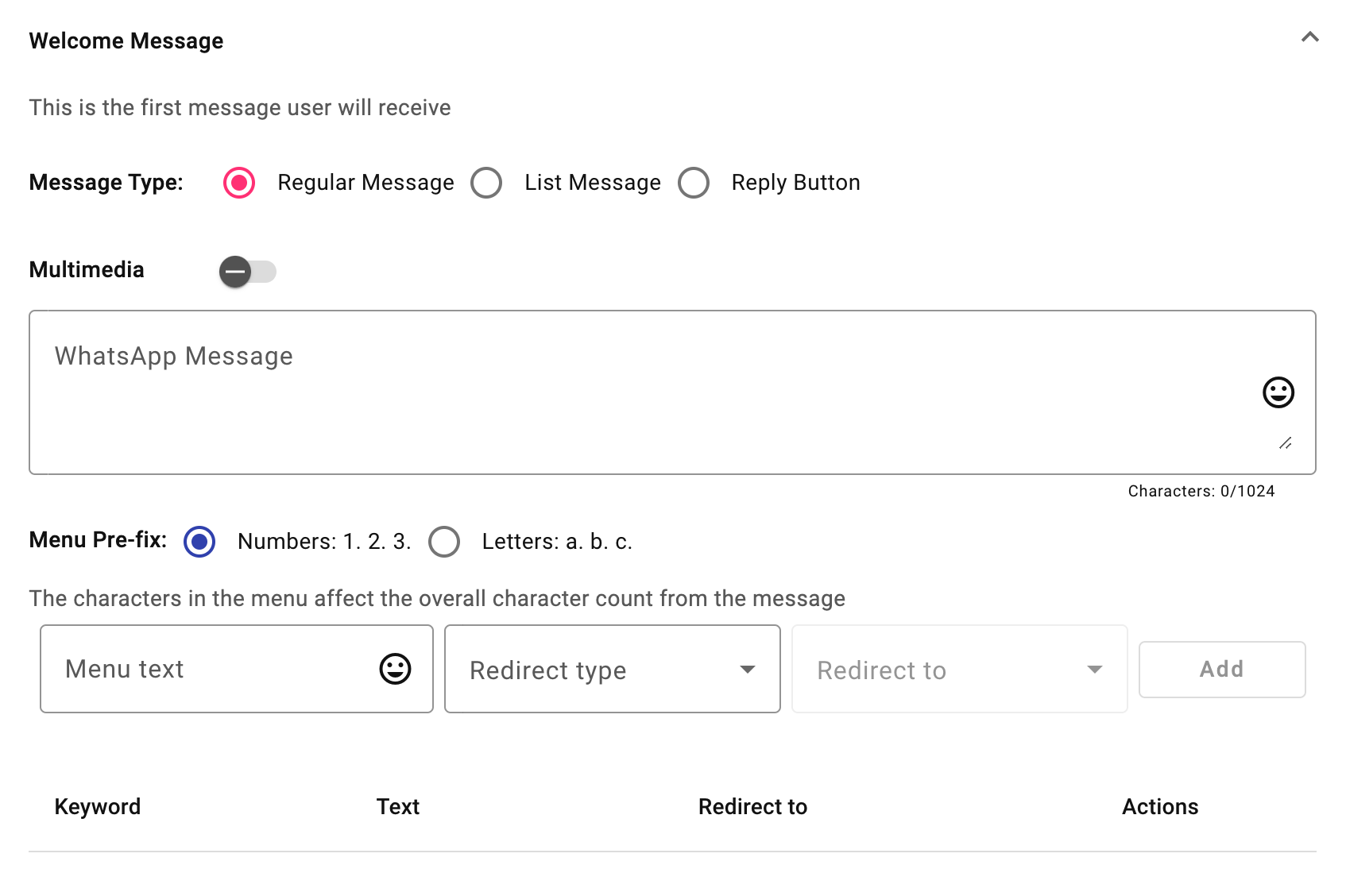
The Welcome Message consists of:
- Choose the interactive message option you want to set (regular message, list message, or reply button) for the Welcome Message configuration.
- Define each welcome message component according to the interactive message option chosen to initiate the conversation with the chatbot.
- Setting the available options that users can pick from.
- Configure the selection menu.
- Specify where the user will be redirected once they select the desired option from the menu.
Interactive Message Options
When setting up the welcome message and interaction, you have the option to configure different types of interactive messages. Interactive messages give your customers a simpler way to find and select what they want from your business on WhatsApp. During testing, chatbots using interactive messaging features achieved significantly higher response rates and conversions compared to those that are text-based.

Here are the available interactive message types:
- Regular Message: A standard text message sent to the user that includes a user-friendly menu with numbered options for resolving common issues.
- List Message: Messages include a menu of up to 10 options. This type of message offers a simpler and more consistent way for users to make a selection when interacting with a business.
- Reply Button: Messages including up to 3 options —each option is a button. This type of message offers a quicker way for users to make a selection from a menu when interacting with a business.
Interaction
Once the Welcome Message has been configured, we proceed to define the Interaction flow.
Here you are going to define how the chatbot will engage with users. It involves creating and organizing a series of automated responses, questions, or actions that the chatbot will execute based on user inputs or triggers. This step shapes the conversational flow, determining how the chatbot will understand and respond to various user inquiries, guide users through processes, or provide information. Essentially, it's about mapping out the dialogue structure the chatbot will use to interact with users when setting the Welcome Message, making the chatbot's interactions more dynamic, personalized, and effective in achieving its intended purpose.
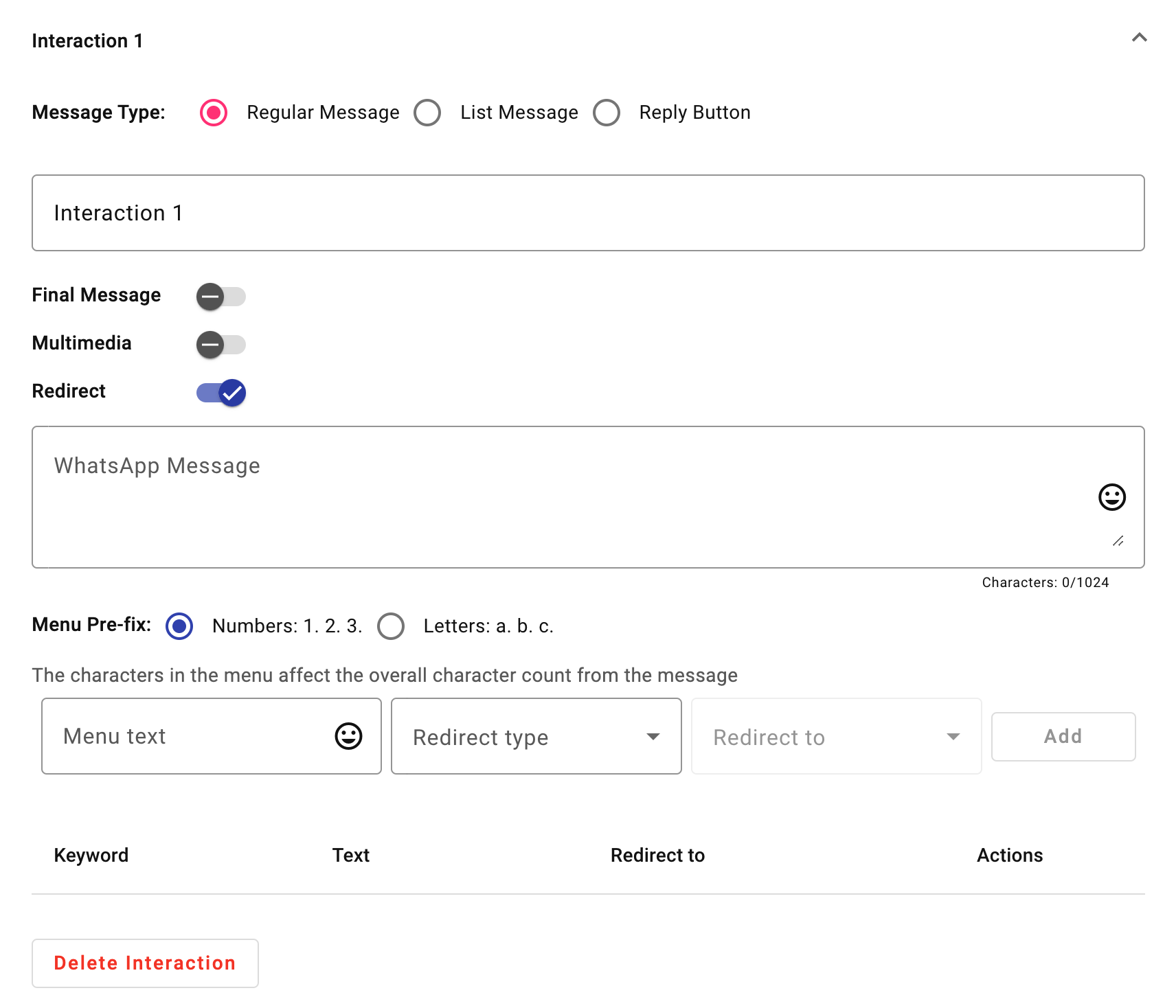
When configuring an Interaction, the steps are identical to those for setting up the Welcome Message. But, in this case, you have the additional choice to redirect it to a different interaction.
To set up an Interaction, follow these steps:
-
For WhatsApp, choose the interactive message option you want to set (regular message, list message, or reply button) for the interaction configuration.
Follow the same steps when setting up the Welcome Message. -
Name the interaction in the provided field.
By default, each interaction name is numbered in order (Interaction 1, Interaction 2, Interaction 3, ….). -
If you choose as interactive message option the Regular Message, decide if this interaction will be redirected to a Final Message or will be redirected to another Interaction by enabling the appropriate toggle.
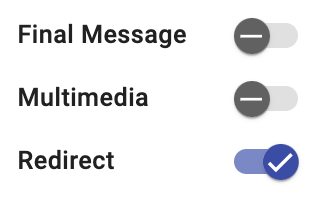
The Redirect toggle switch will be enabled by default. However, at the end of a flow, whether there is only one or several within the service, there will be no action that follows this step and it is where the Redirect toggle switch will need to be placed in the disabled position.
NOTEWhen the Redirect toggle is disabled, the Final Message toggle will be automatically activated. Once activated, the interaction will be redirected to the final message that will be displayed when the user has finished interacting with the chatbot.
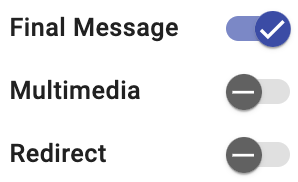
If the Interaction has set up an options menu, but one or more options are redirected to another interaction or integration, a message will be displayed mentioning that the Final Message can only be sent if one or more options are redirected to interactive campaigns or webhooks.
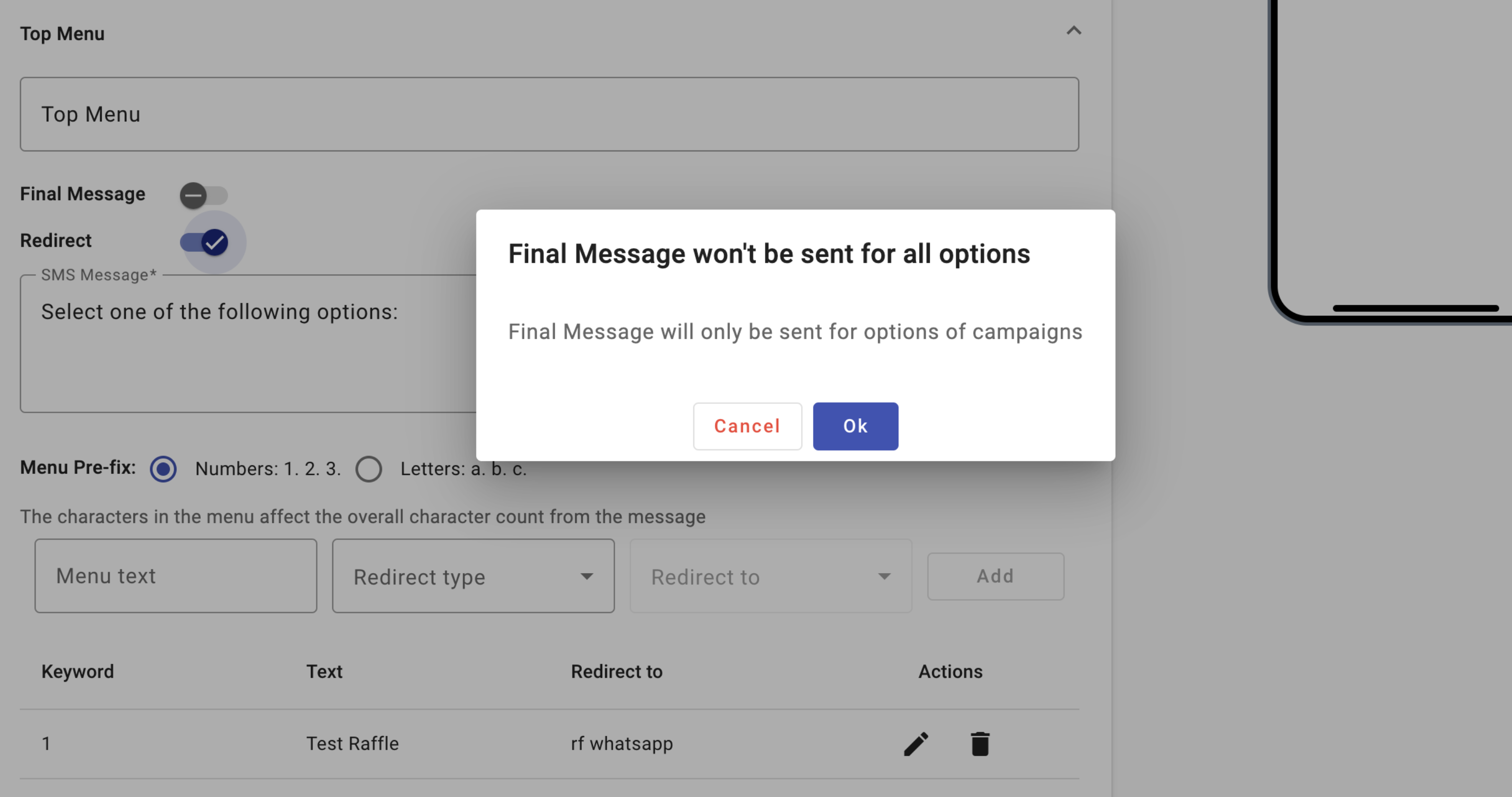
Therefore, the Final Message and Redirect toggles can be activated both if one or more options are redirected to interactive campaigns.
For more information on setting the Final Message, please refer to the Final & Error Message section.
NOTEThe maximum number of chatbot interactions that can be configured is 100. This limit includes all interaction types, such as the Welcome Message, Final Message, and Error Message.
For SMS (API Endpoint) the limit is 101 interactions, which includes the Invitation Message, Welcome Message, Final Message, and Error Message
-
To configure the available options that users can pick from, follow the same steps when setting up the Welcome Message:
- For Regular Message: Setting Pre-fix Menu, Menu Text, Redirect Type, Redirect To.
- For List Message: Header, Message Body, Footer, Options Title, Section Configuration, List Configuration.
- For Reply Button: Header, Message Body, Footer, Button Configuration .
Once defined the Invitation Message (For SMS, API Endpoint), Welcome Message, Interactions, Final Message, and Error Message, click on the Next button to proceed to the final review step before the chatbot goes Live.
Updated 3 months ago
